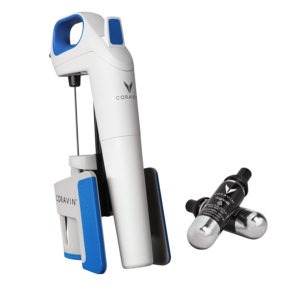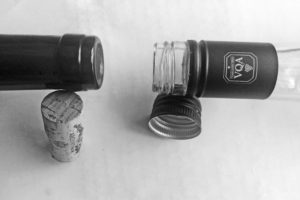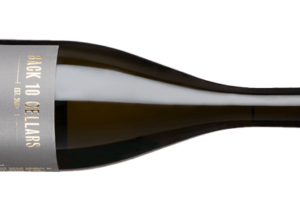Product Review: Coravin Model One ($259.99 at Bed Bath & Beyond)
To be honest, I don’t know a lot of people who have issues with wine spoiling, since a freshly opened bottle is not likely to last them beyond a few hours, much less a few weeks. But rumour has it that these people exist. And thankfully there is a product that caters to such a crowd: the Coravin wine preservation system.
 The Coravin, in fact, will actually change the way you think about drinking wine. As its tagline notes, it’s freedom to pour wines without pulling the cork. Does one guest prefer a glass or two of Chardonnay with tonight’s turkey dinner? Rosé for another? Pinot Noir for yourself? In this scenario, everybody can get what they want, without the concern of spoilage.
The Coravin, in fact, will actually change the way you think about drinking wine. As its tagline notes, it’s freedom to pour wines without pulling the cork. Does one guest prefer a glass or two of Chardonnay with tonight’s turkey dinner? Rosé for another? Pinot Noir for yourself? In this scenario, everybody can get what they want, without the concern of spoilage.
The product also addresses those who have bottles they’ve been cellaring for special occasions (I personally know of many who have allowed their prized possessions to drift past the best-before date, only to be disappointed with the quality of their pricey vino once the cork was pulled). But since the Coravin allows you to have a glass—or even a sample—at a time, without exposing any oxygen to the wine inside the bottle, it sort of gives you the run of the mill of your wine cellar on random occasions.
Here’s how it works: Unlike traditional preservation systems, which require the cork to be pulled and therefore allow oxygen to enter the bottle, the Coravin leaves the cork in place to continue protecting the wine. It does so with the use of a micro-thin but hollow needle. Simply place the Coravin on top of the bottle (the device clamps on to the bottle neck) and then push the needle down and through the cork (it only works on cork-sealed, still wines). Tip the bottle as if you are pouring from an open bottle. Quickly press the trigger to pressurize the bottle with argon gas (an inert gas that does not react with wine and has no effect on the taste profile). Release the trigger to pour into your glass. Tip the bottle back up to stop the pour. Remove the needle by pulling the system straight up. The cork will reseal naturally and continue to protect your wine for weeks, months—even years, they claim.
(The company has also developed a screw cap accessory that enables wine lovers to enjoy and preserve bottles sealed with a screw cap for up to three months.)
Coravin estimates that a bottle cork can be punctured upwards of 25 times before the cork becomes compromised. I’ve personally revisited the same bottle of Frescobaldi Castiglioni 2016 Chianti for nearly two months and the flavour profile and acidity are still like new. (One tip: Use very short bursts of gas initially when pouring until you get a feel for the unit.)
Each of the two argon gas capsules provided will allow you to access approximately 15 five-ounce glasses of wine (you can purchase additional two-packs as required for about $30). Capsule longevity will vary depending on how you use the Coravin System and how often and how much you pressurize each bottle.
Note that sparkling wine is a no-no for the Coravin since those bottles are already pressurized and could explode. Which is sort of a shame, since a bottle of bubbly is the one type of wine I really wish I could enjoy by the occasional glass, and then put away for future use.
Maintenance-wise, remember to purge the needle with a quick trigger of gas after every use to ensure no oxygen in introduced into the bottle. And wash the needle after use.
While the Coravin will appeal to folks who take their sweet time to reach the bottom of a bottle, it is an even better fit for restaurants that wish to keep the contents of multiple bottles (especially high-priced ones) as fresh as the day the cork was popped.
Midfield Wine Bar in Toronto is among many facilities that has prospered from the product’s ability to expand their wine-by-the-glass menu.
“We think for our needs it’s worth the investment,” says Midfield wine director and manager Annette Bruley, “It allows us to offer an extensive selection with very little wastage. We run through our by-the-glass selection fairly quickly, even with the premium wines, so it makes sense for us. We’re a small space, so looking into larger wine preservation systems is pointless.”
MIANTENANCE
And what about maintenance? “There are very limited options for ordering supplies, but they’re readily available when you want them,” Bruley notes. “The teflon on the needle wears down easily if you’re not careful, which could lead to snapping the needle. We make sure to cut the foil first before running the needle through the cork in order to avoid scraping off the teflon. Cutting the foil first also allows you to see what kind of cork is in the bottle. You don’t want to jam your needle into a glass cork! And we’ve learned through experience to check the corks once we cut the foil. Synthetic corks and cheap corks don’t work, so we’ll open those bottles and immediately replace them with an appropriate cork. We use the (slightly thicker) fast-pour needle since we’re using the Coravin for service, and that needle wears down the cork pretty quickly.
“We’ve got an older version of the Coravin, so I don’t know if they all do this, but sometimes trying to unscrew the handle when you want to replace a capsule is virtually impossible. I’ve had to pass it over to the kitchen staff sometimes to unscrew it,” Bruley adds. “And the needle often gets clogged from the cork—perhaps more so with the fast-pour model of needle. Sometimes the staff think the capsule has run out when this happens, and instead of checking the needle they try and replace the gas capsule and waste the one in use. If any problems come up in the middle of a busy service, having to figure out what is wrong and then remedying the situation is a pain. But I guess we have to embrace that part.”
But even if the cork passes the test, the Coravin is not for every wine, Bruley notes. “We serve a lot of low-intervention/natural wine that doesn’t work well with the Coravin. Those bottles are better off being served like the rest of our by-the-glass list due to the benefits of exposure to oxygen. And some of those wines also have a lot of sediment that clogs the passageways in the Coravin.”
The drawback of the device’s by-the-glass approach is that since you’re not removing the cork, the only way for your wine to properly breathe is in the glass. But then your intention was never to consume the whole bottle to begin with, so no sympathy there.
Not all are true believers. A prominent Toronto wine agency I spoke with contended, “It doesn’t always work. Some wines remain very clean, but some may still experience oxidation. Why? We don’t know—it could be the quality of the gas used, but it could also be the quality of the cork.”
So far I’m four-for-four in my personal trial. And as someone who reviews wines, when 15 bottles get dropped off to sample a ounce or two or each, you really appreciate the value of a Coravin!





Leave a Reply
Your email is safe with us.